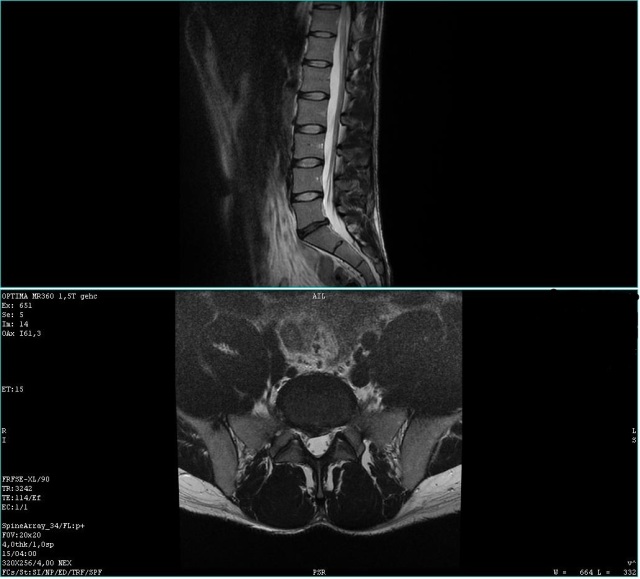Question
 RMI
RMI
Hello doctor.
Could you share your personal opinion regarding the following problem please?
I have attached a picture of my L5 - S1 lumbar disc. As you can see, i have a bulge/herniation that is compressing my right side sciatic nerve, giving me moderate chronic ain for abot 2 years now. I have been told that the problem is the sacrum being angled like that (too far back) and i have been put through different exercises to reverse it forward. Another doctor told me that my lordosis is missing, so i should correct that. I'm pretty confused here, as the exercises for the two mentioned problems exclude each other (hopefully i'm not mistaking), so please help me with your own opinion.
I'm a fit person, 13-15% body fat, all muscle, at a semi-pro level (at least this is how i'd describe myself :) ). Unfortunately I have to sit at a computer for 8 hours per day. Working out at the gym with weights is usually done in the evening. I love fitness very much, but this problem has stopped me in my tracks. Should i stop weight lifting?
Any other information you consider important is much appreciated. I can provide aditional feedback on my condition / symptoms if you consider so.
Thank you very much.
AnswerDear Corneliu,
Your advisors are wrong about your sacrum or lordosis. You clearly have a disc bulge that is against the nerve canal. I would have to see a few different MRI images to see if there is nerve contact or nerve contact with displacement, or if there is just a tight nerve canal without nerve contact. The way we understand spine conditions and how to treat back problems has changed over the years. It is pretty obvious that your disc is the cause of your pain. One of the first things you need to know is if there is a "directional preference," whereby you can bend in a particular direction and experience pain relief. The next thing to know is if there is instability, where one bone is loose (unstable) and moving back and forth, thus grinding and irritating the disc. This can be determined by performing a Prone Instability Test (PIT). You can see the PIT on an internet search. Or click here: http://www.udel.edu/PT/PT%20Clinical%20Services/journalclub/sojc/08-09/Oct08/Har
If you have a positive PIT, then you must do stability exercises: prone plank and side plank; If you have a directional preference, such that when you arch backwards your sciatic leg pain goes away, then you must do exercises into that direction. If you have a direction that increases your sciatic leg pain, then you must stop doing them. For some folks, they have to give things up in the gym, like squats, deadlifting, and ab' machines, and cross train with other exercises like "split squats" and "spine-neutral" core exercises like planks. Also, in general, lumbar spine flexion puts pressure on the disc, and for many people they believe that doing sit-ups is going to help their back problem when, in fact, it will likely make it worse. Lastly, if your condition is getting worse, and this means that you are getting more and more pain in the leg/foot over time, or that you are losing your reflexes (e.g. knee-jerk reflex) or losing the strength of your calf or foot/toe muscles, then you may have to have a "micro-discectomy" to remove the portion of the disc. You may also require fusion of the bones if your condition is surgical and it is there is concern of instability. If you can do the right things on your own and get better, then keep on doing them and determine if you can go back to some of your gym activities. As far as treatment goes, one method that has helped people with discs like yours is the flexion-distraction or "Cox" methods. You can see me doing this to a disc patient on this video from my web site: http://www.drgillman.com/drgillman/pages/services.htm#
I hope this was helpful.


